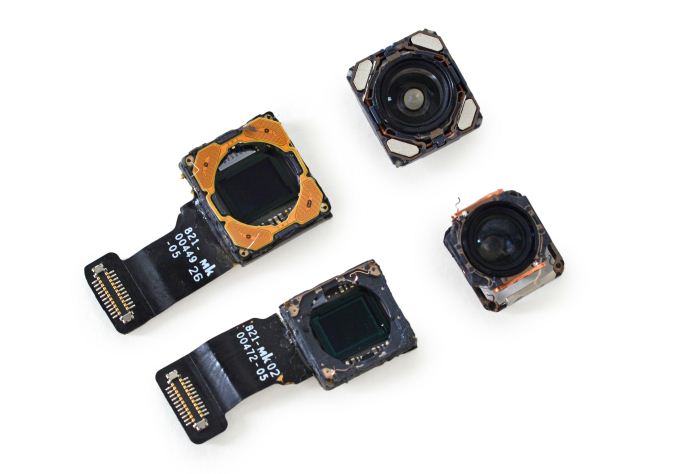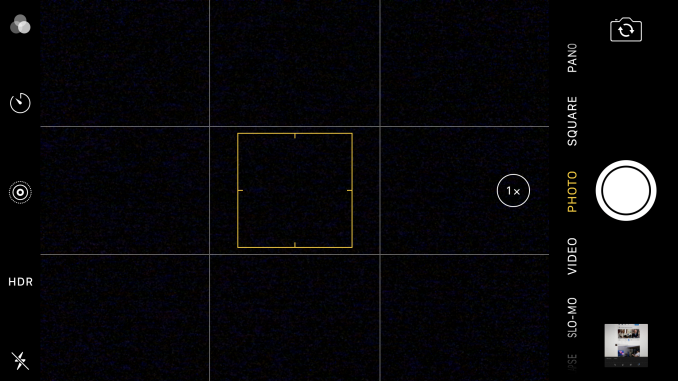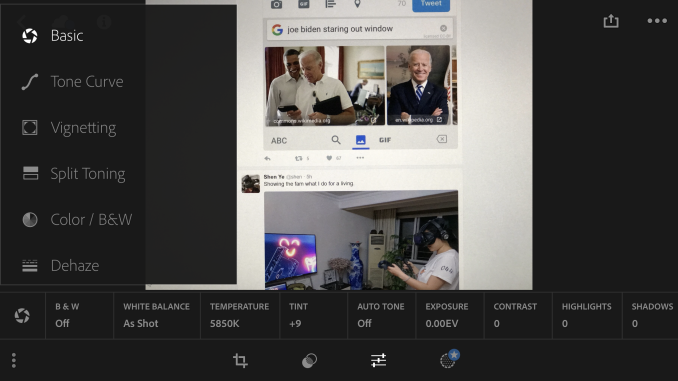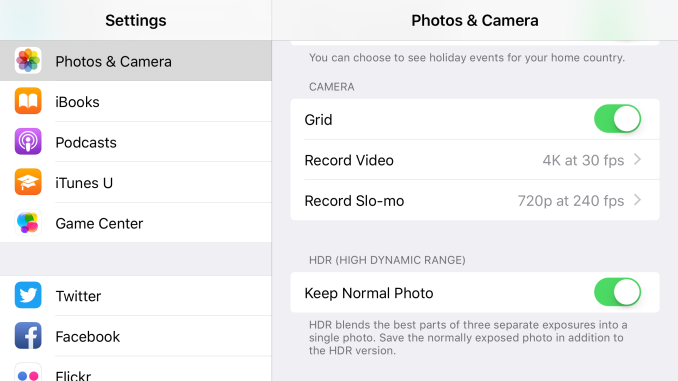The iPhone 7 and iPhone 7 Plus Review: Iterating on a Flagship
by Joshua Ho & Brandon Chester on October 10, 2016 8:00 AM EST- Posted in
- Smartphones
- Apple
- Mobile
- iOS
- iOS 10
- iPhone 7
- iPhone 7 Plus
Camera Architecture
Before we get into the results of the camera output it's always helpful to actually examine the basic characteristics and hardware that make up the camera as a number of characteristics can be predicted or understood by looking at the basic hardware. The CIS technology used can have significant impacts on noise, active area, and a number of other features including slow motion video capture. However, to say that the CIS is the only area worth examination ignores the whole chain of hardware and software needed to make a great camera. With that said we can start our look at the camera with the table below which summarizes a number of high level details for the camera.
| Apple iPhone Cameras | ||||
| Apple iPhone 6s Apple iPhone 6s Plus |
Apple iPhone 7 Apple iPhone 7 Plus |
|||
| Front Camera | 5.0MP | 7MP | ||
| Front Camera - Sensor | Sony ? (1.12 µm, 1/5") |
Sony Exmor RS (1.0 µm, 1/?") |
||
| Front Camera - Focal Length | 2.65mm (31mm eff) | 2.87mm (32mm eff) | ||
| Front Camera - Max Aperture | F/2.2 | F/2.2 | ||
| Rear Camera | 12MP | 12MP | ||
| Rear Camera - Sensor | Sony Exmor RS (1.22 µm, 1/3") |
Sony Exmor RS (1.22 µm, 1/3") |
||
| Rear Camera - Focal Length | 4.15mm (29mm eff) | 4mm (28mm eff) 8mm (56mm eff) Secondary |
||
| Rear Camera - Max Aperture | F/2.2 | F/1.8 F/2.8 Secondary |
||
Looking at the camera of the iPhone 7 in some ways the cadence has changed up a bit. While the iPhone 5s to iPhone 6 transition saw the use of almost identical camera sensor and optics, the iPhone 7 actually changes things up relative to the camera that we saw in the iPhone 6s, likely because the difference between the iPhone 6 and 6s camera was fairly mild in still photos. The iPhone 7 still appears to use a similar sensor on the rear, but with a new set of optics that incorporates a wider aperture. Apple seems to be fighting against serious z-height limitations, so we’re continuing to see a reduction in focal length as the iPhone 7 is now basically comparable to phones like the One M7 with its 28mm equivalent focal length. It’d be interesting to know transmission efficiency which would allow for proper comparisons between generations but considering how most dSLR lenses don't' list these specs it's not a surprise that we don't see this kind of disclosure.

iPhone 7 Plus's dual camera modules (Image Courtesy iFixit)
What isn’t listed on the spec sheet is that the iPhone 7 now has OIS, which is going to be a serious step up in terms of performance for anyone upgrading from the iPhone 6 or 6s. While Apple has some proprietary EIS that allows for really impressive performance despite the lack of OIS, a physical mechanism to compensate for hand shake is going to make for a more effective system in the first place, as it fixes the problem before the photons are captured. Apple continues to use advanced software to enable long exposure without visible blur or hand shake so the addition of OIS shouldn’t have any noticeable drawbacks other than increased shot latency in low light.
Of course, the iPhone 6s Plus already had OIS, so for the iPhone 7 Plus there is a new secondary camera with a focal length that is twice as long as the primary camera. However, the aperture is smaller, which means that in low light the system is going to automatically fall back to the primary camera which is still better in low light as far as I can tell, especially because the second camera lacks OIS. However, in bright daytime conditions the second camera’s longer focal length allows for better portraits and better detail in general. This helps to compensate for the iPhone’s sensor size and z-height limitations, but can only really help in daytime conditions.
Interestingly enough, Apple is actually one of the first OEMs to my knowledge to adopt a 1 micron pixel pitch for a camera sensor, but this is being done for the front-facing camera. I’m kind of curious to know what led to this decision as the optics are probably not going to be able to resolve such a small pixel size. We generally don’t review front-facing cameras but for the people that care about this sort of thing I suspect that the FFC is mostly a sidegrade in the sense that it’s probably going to be used to enable higher resolution video capture rather than higher quality still photos.
Camera UX
As far as the camera application goes, there’s really nothing new this generation. If you’ve taken pictures with a relatively new iPhone, you’re going to be right at home with the iPhone 7’s camera UI. For those that haven’t used a relatively new iPhone before we can do a quick review to discuss what is and isn’t present. At a high level, the UI is split up into a few logical sections, with mode-specific options in their own section. Modal selection is on the opposite side, with text that fairly clearly delineates the purpose of each mode. Below the modal selection, general options are presented for things like changing between front and rear cameras as well as the shutter button and camera roll.
It's hard to really say much about the iPhone camera UI at this point because it’s been polished to the point that there’s really no obvious criticisms to make about it. Apple may have made the mistake of shipping a 16:9 preview for a 4:3 camera before, but it’s been years since glaring issues like that have come up. Tapping to focus allows for either locking focus and exposure or biasing the exposure, which is going to provide coverage for 95% of still image cases. Of course, if you want more fine adjustment the default camera app is going to be inadequate, but there are plenty of good manual camera applications on the market like ProCam, ProShot, and Manual Camera.
It’s worth mentioning that while Apple was far from first to implement RAW capture on smartphones, their implementation is differentiated by a real end to end solution. Something like the HTC 10 really needs Lightroom to bring out the best in its RAW captures, although Snapseed is still reasonably useful in a pinch. Apple is leveraging their ecosystem which allows for things like fully featured Adobe Lightroom for RAW processing. I thought for a very long time that processing RAW was infeasible in the context of a smartphone TDP without fixed-function hardware, so it’s incredibly impressive to see Lightroom working smoothly when processing RAW images.
While most of the camera UX is designed well, one noticeable issue here is that the camera settings are integrated into the settings application rather than the camera application itself. If you’re used to how iOS works this makes sense, but things like resolution settings for video are placed in this menu rather than integrated into the camera application which makes switching between these settings relatively painful if you’re used to something like the HTC 10’s camera UI which places resolution settings in a slide-out drawer. This isn't a huge issue but it's definitely something I noticed due to the need to rapidly switch between resolution settings for video testing. Your mileage may vary here if you don't particularly care for such issues. Overall though, the camera UX has few friction points.













377 Comments
View All Comments
willis936 - Monday, October 10, 2016 - link
That is some serious double think in the conclusion about justifying the lack of a headphone jack. I doubt it's willful ignorance but not addressing valid concerns or opposing arguments and just painting it as God's Gift To Consumers is sad. Also while I appreciate the lax style of writing it seems to give a healthy sense of opinion. Opinion is fine, this is a review, but when opinion feels influenced by emotion it looks bad. I see comparison to android and highlighting of how iOS is better but you make no mention of all of the missing features in iOS compared to android. OEMs don't care about the details in large yet you talk about HTC so often who is a competent system integrator. Android need to catch up on SoCs, storage, and cameras. That's about it.MathieuLF - Monday, October 10, 2016 - link
Many Android manufacturers have caught up with cameras though. Samsung notably and now the Pixel as long as Google's claims are true about the camera. But yeah you're right that this review was pretty pro-Apple biased but I guess it's no real surprise.willis936 - Monday, October 10, 2016 - link
I guess my main complaint with android cameras is the notable lack of OIS.lilmoe - Monday, October 10, 2016 - link
Samsung's latest phones are the class leaders here. Nothing really compares. But that's just for the Exynos variants. Qualcomm screwed up again their encoder blocks.tuxRoller - Tuesday, October 11, 2016 - link
That's interesting.Is there some link you have that provides evidence of this?
jtang97 - Tuesday, October 11, 2016 - link
I had to read you comment a second time because I read it as,"I guess my main complaint with android is the notable lack of IOS."
lolipopman - Tuesday, October 11, 2016 - link
How is it biased? How can you deny the GPU improvements? Significantly, far superior than anything on the market.prophet001 - Monday, October 10, 2016 - link
Let the kool-aid flow.smh
lilmoe - Monday, October 10, 2016 - link
"Android need to catch up on SoCs, storage, and cameras"Nah. SoCs are fine, and faster in lots of aspects than Apple's offerings. UFS 2.0 storage is also comparable with Apple's "SSD" implementation in sequentials, yet faster in randoms. The cameras *have been* better for a while.
I totally understand, and respect, others' opinions of preferring Apple products. I also was sort-of impressed during their announcements. But after further hands on with the new devices, reading some reviews, and comparing them with the previous 6S (first hand), I wholeheartedly recommend Apple lovers to skip this generation all together and save themselves a couple of bucks (and headphone headache). If you want an iPhone, I would definitely recommend the 6S (which also has better battery life).
solipsism - Monday, October 10, 2016 - link
lilmoe wrote, "I would definitely recommend the 6S (which also has better battery life)."So AnandTech's review is a lie?
• http://www.anandtech.com/show/10685/the-iphone-7-a...